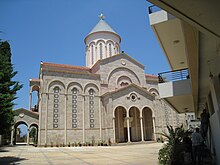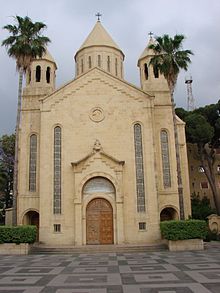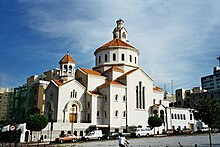Armenians in Lebanon


The Armenians in Lebanon ( Armenian Լիբանանահայեր Lipananahajer , Arabic اللبنانيون الأرمن) are Lebanese citizens or newcomers of Armenian origin, who mostly speak Western Armenian as their mother tongue. The Armenian community in Lebanon essentially emerged in the post- Great Genocide period when Armenian refugees found refuge in Lebanon.
Ethnic and religious affiliations have not been recorded in Lebanese censuses since 1932, but Al-Monitor, for example, gives the number of Armenians in Lebanon at almost 150,000, which makes up around four percent of the population. Their number was significantly higher before the Lebanese civil war , but has since decreased due to emigration. The Armenians of Lebanon are among the groups of the Armenian diaspora with the greatest influence in their country. Most of the Armenians in Lebanon belong to the Armenian Apostolic Church , but some are members of the Armenian Catholic or the Armenian Evangelical Church .
history
Until the time of the Ottoman Empire , there were very few Armenians in today's Lebanon. This changed above all after the genocide of the Armenians from 1915, when surviving Armenians found accommodation in the Karantina district of the Lebanese metropolis of Beirut and later in neighboring Bourj Hammoud .
When in 1939 the French mandate power for Syria and Lebanon left the Syrian area of Alexandretta first to the State of Hatay and then to Turkey , most of the residents (all Armenians except for those in Vakıflı ) fled this area, with many Armenians and other oriental Christians settled in the Lebanese Bekaa Valley . The Armenians who fled from Moses Mountain founded the small town of Anjar in 1939 , which is still entirely Christian and Armenian-speaking today. Some of the makeshift refugee camps for Armenians were later to serve as camps for Palestinian refugees.
During the Lebanese Civil War , the Armenians in Bourj Hammoud and Anjar did everything they could to remain neutral. So Bourj Hammoud was spared from acts of war to a greater extent than other parts of Beirut. There were some armed Armenian organizations in Lebanon, such as the Asala with their later antagonistic leaders Hagop Hagopian and Monte Melkonian , the Justice Squads of the Armenian Genocide (JCAG) and the Armenian Revolutionary Army (ARA), which used the country as a base of operations.
At the request of the six Armenian MPs in the Lebanese Parliament , on April 4, 1997, the Lebanese Parliament unanimously passed a resolution recognizing the genocide of the Armenians , with Lebanon officially recognizing the genocide as such today. Before the civil war began in 1975, about 300,000 people lived in Lebanon; today it is still around half: many emigrated to the USA , Canada , Australia or France , some also to Armenia, which became independent in 1991.
Settlement areas
A large number of the Armenians in Lebanon live in the Beirut suburb of Bourj Hammoud , which is also known as the "heart of the Armenians" of Lebanon. The majority of the population of Bourj Hammoud, numbering over one hundred thousand, is Armenian and speaks Western Armenian , but other Christians as well as some Shiites and Kurds also live here . In the course of the Lebanese civil war, a wave of emigration began. Since the fall of Saddam Hussein and the ensuing armed conflicts in Iraq from 2005 and the Syrian civil war from 2011, Bourj Hammoud has taken in many Christian refugees from these countries, especially Armenians from Iraq and Syria . However, the arrival of non-Armenian immigrants and refugees on the one hand and gentrification tendencies on the other have also led to discontent among the local Armenians in Bourj Hammoud.
Anjar in the Bekaa Valley , which was founded in 1939 by refugees from Mount Moses, is still practically a purely Armenian place today , although it only has about 2400 inhabitants.
The Catholicos of Cilicia of the Armenian Apostolic Church has his seat in Antelias and his summer residence in Bikfaya . The Patriarchate of Cilicia of the Armenian Catholic Church , on the other hand, has its seat in the Bzommar Monastery . There is an Armenian orphanage in Jbeil ( Byblos ).
Political representation
According to the current Lebanese constitution, of the 128 seats in the Lebanese parliament, five seats are for members of the Armenian Apostolic Church and one seat for an Armenian Catholic in the following constituencies:
- an Armenian Apostolic and an Armenian Catholic seat in Beirut I.
- two Armenian Apostolic Seats in Beirut II
- an Armenian apostolic seat in Matn
- an Armenian Apostolic seat in Zahlé
Since many Protestants in Lebanon are ethnic Armenians, an Armenian has sometimes been elected for the only seat in parliament for the evangelical community, so that there were sometimes seven Armenian members in the Lebanese parliament. There has always been at least one Armenian minister in the Lebanese government, and two in larger governments.
There are three major Armenian parties in Lebanon: the Armenian Revolutionary Federation (Taschnag), the Social Democratic Huntschak Party (Huntschak) and the Democratic-Liberal Party (Ramgawar).
Educational institutions

Lebanon is the only country with an Armenian university outside of Armenia, Haigazian University , founded in 1955 , the language of which is English.
Most Armenian schools are run by one of the three Armenian churches, although some are run by cultural associations such as Hamazkayin and Armenian General Charity Union (AGBU).
media
Daily newspapers
The three Armenian daily newspapers that appear in Beirut are mouthpieces for the three traditional Armenian parties:
- Aztag is the daily newspaper of the Armenian Revolutionary Federation (Taschnak) and was founded in 1927. There is an online version in English and Arabic.
- Ararad is the daily newspaper of the Social Democratic Huntschak Party (Huntschak).
- Zartonk is the daily newspaper of the Democratic-Liberal Party (Ramgawar) and was founded in 1937.
The first Armenian-language newspaper in Lebanon was "Pyunik", which was replaced by Aztag in 1927.
Weekly and monthly newspapers
Examples of Armenian weekly and monthly newspapers in Lebanon are:
- Hasg , official organ of the Cilicia Catholic of the Armenian Apostolic Church
- Avedik , official organ of the Armenian Catholic Church
- Yeridasart Hayouhi (women's literary newspaper ), later Yeridasart Hay .
- Nor Gyank (New Life), Lifestyle Magazine
- Gantch , Armenian communist weekly newspaper (part of the Arabic-language communist newspaper "An Nidaa")
- Khosnag , official body of the Armenian General Charitable Union (AGBU)
- Pakine , literature and culture
- Shirak , literature and culture
- Spurk , literature and culture
- Massis , Armenian Catholics
- Badanegan Artsakank , Armenian Protestant, youth
Academic yearbooks
- Hasg Hayakidagan Hantes , Armenological Yearbook of the Catholic of Cilicia
- Haigazian Armenological Review , Haigazian University Armenological Yearbook
radio
The Lebanese state radio broadcast daily radio programs in Armenian on its second multilingual channel and continues to do so today. During the civil war, some Armenian radio stations were founded without a license, some with 24-hour programming, including pioneered Radio Paradise and later Vana Tsayn (voice of Van ). After the Lebanese parliament passed laws on this, all Lebanese channels had to close without a license. Today there are two licensed Armenian-language full-time broadcasters in Lebanon: Vana Tsayn and Radio Sevan .
watch TV
Occasional Armenian language television broadcasts have occasionally been made on private and state broadcasters. In Lebanese, the Armenian television broadcaster Paradise Television cooperated with Radio Paradise in Bourj Hammoud, but Paradise Television had to close due to the lack of a license. Mustaqbal Television (Future Television) and OTV broadcast 30-minute news and commentary in Armenian daily as part of their regular programming.
literature
- Nicola Migliorino: Constructing Armenia in Lebanon and Syria: Ethno-Cultural Diversity . Berghahn Books, New York 2008.
Web links
- CIA World Factbook, 2007
- Michael Däumer, Johannes Grundberger, Sebastian Grundberger, David Lüngen: A minority with power. Konrad-Adenauer-Stiftung eV, July 22, 2009.
- religion
- Armenian Catholicosate of Cilicia Official site
- Armenian Catholic Church Official site
- Armenian (Orthodox) Prelacy of Lebanon
- Media
- Ararad Armenian Daily
- Aztag Armenian Daily (Armenian) - Arabic supplement - English (daily)
- Zartonk Armenian Daily
- Radio Sevan Armenian Radio Station
- Voice of Van Armenian Radio Station
- society
- Homenetmen Lebanon Official site
- Lebanese-Armenian community site
- Official site of Anjar, large Armenian town in Bekaa, Lebanon
Individual evidence
- ↑ Knut Mellenthin: Civil War in Lebanon - Causes and Course. Junge Welt , March 1, 2005.
- ^ Jean Aziz: Turkish-Armenian conflict rears its head in Lebanon. ( Memento of the original from December 2, 2017 in the Internet Archive ) Info: The archive link was automatically inserted and not yet checked. Please check the original and archive link according to the instructions and then remove this notice. Al-Monitor, March 30, 2015.
- ↑ Lebanon Minorities Overview, February 22, 2014 ( Memento of February 22, 2014 in the Internet Archive )
- ↑ Nicola Migliorino: Constructing Armenia in Lebanon and Syria: Ethno-Cultural Diversity . Berghahn Books, New York 2008. p. 166.
- ^ Camps in Lebanon
- ↑ Lebanon Recognizes the Armenian Genocide
- ↑ Sarine Karajerjian: Bourj Hammoud Opens its Doors to Refugees Yet More. News Deeply, May 10, 2016.
- ↑ Adrian Hart Rick: Beirut's 'Little Armenia': A Haven Of Diversity 101 Years After The Genocide. Refugees Deeply, Huffington Post, May 10, 2016.




